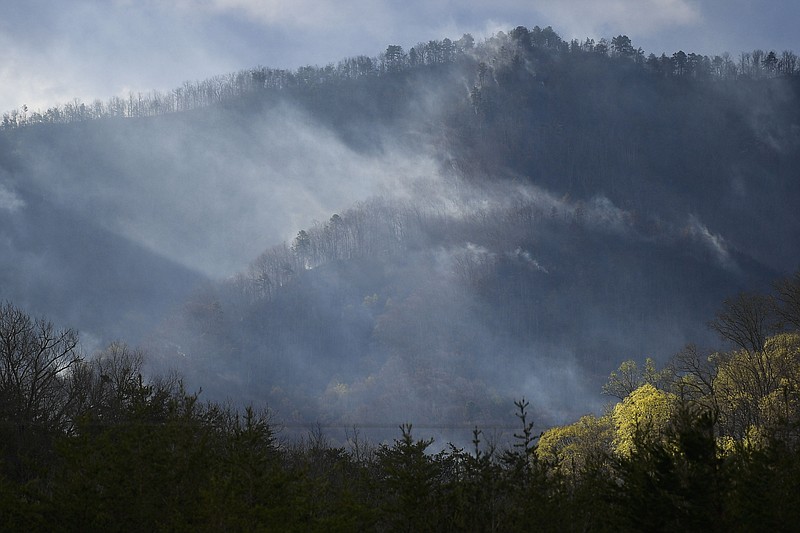Perhaps you haven't noticed the weather warnings over the past week to be careful with fire because of high winds and low humidity - even just after night rains. Perhaps you didn't notice the small wildfire on the side of Signal Mountain just south of the "Space House" on Highway 127 on one of those afternoons.
But it's a good bet you've heard on the radio or seen in the news or on social media that Tennessee icon Dolly Parton on Friday was asking for prayers to help the firefighters working to fight wildly spreading flames in the Smokies and in East Tennessee.
The Hatcher Mountain/Indigo Lane fire in Wears Valley started Wednesday and by late Thursday had spread to more than 3,700 acres. Another fire at Millstone Gap had reached 650 acres in size. Our local firefighters were called to help.
Meanwhile, in Antarctica, the Thwaites Glacier was continuing to crack and melt as temperatures there were soaring 40 to 70 degrees above normal.
Yes, all that fire and ice news is related. Both are being affected, even driven, by global warming.
The Thwaites Glacier is the size of Florida and holds enough ice to raise global sea levels at least two feet. In December, scientists noticed new massive cracks in it. Last week an ice shelf dubbed the Conger Ice Shelf - nearly the size of Los Angeles - disintegrated on the other side of Antarctica,
"I don't think there has been a shelf collapse like this in East Antarctica since we've been able to receive satellite data," Rob Larter, a marine geophysicist at the British Antarctic Survey, told CNN. "Conger is a very small ice shelf which has been decreasing in size for many years, and this was just the final step which caused it to collapse."
Not only is the air warmer in Antarctica, the ocean water is too, and the combination is causing rapid and radical glacier melting.
Thwaites Glacier serves as a bottleneck protecting the larger West Antarctic ice sheet. When globally warmed sea water and higher temperatures get to that larger ice shelf and it goes, scientists say its melt and collapse would raise sea level 10 feet - were it to melt completely.
Thwaites, possibly the world's most watched lump of ice, could one day become one of the most significant drivers of global sea level rise. There's a reason its nickname is Doomsday Glacier.
"It is the most important glacier in the world," Julia Wellner, a marine geologist at the University of Houston, recently told National Geographic.
The Earth's seas already are rising faster every year. Against that backdrop, any news of massive ice melts - like the unexpected collapse of Conger - from Antarctica worries scientists. As more ice shelves collapse - which the cracks along the tip of Thwaites foretell - creeping runoff and infiltrating sea water could speed polar melting and eventually affect the 110 million people worldwide living where coastal flooding already occurs regularly during high tides.
Earlier this year, NOAA predicted seas would rise a foot by 2050 on U.S. coasts-and two feet by the end of the century.
"It's not a question of if seas will rise two feet. It's when," University of Delaware sociologist A.R. Siders told National Geographic. "We just have to make the decision [to adapt], even with some uncertainty."
Perhaps the Smokies might someday be beachfront property? It's a joke, but not a funny one.
Globally, seas have risen a little over 8 inches since 1900, but the rise is accelerating: A quarter of that rise has happened just since 2006.
Some regions, like the U.S. East Coast, are seeing a faster rise than the global average. That's because scientists say our coastline is also being affected by the Gulf Stream slowing and funneling less water away from the coast.
In the Smokies this week, people remember the 2016 Gatlinburg inferno that killed 14 people, injured 200, caused massive property damage and charred about 17,000 acres of woodlands. This week's fires prompted schools to close, and Sevier County emergency workers were telling people to evacuate their vacation cabins - all this despite the week's storms and rains.
Speaking of those storms, weather.com is reporting preliminary weather counts indicate March - with 233 reports of tornadoes in the Southeast - may be the most tornadic March since 2017. The average number of March tornadoes is 83.
Sure, we can call it wacky weather. But we can also say it's climate change. Whatever we term it, we need to stand on the heads of our political leaders and utility executives to make them pay attention and take appropriate action by moving sooner - not later - to alternative energy.
Sing it, Dolly.
